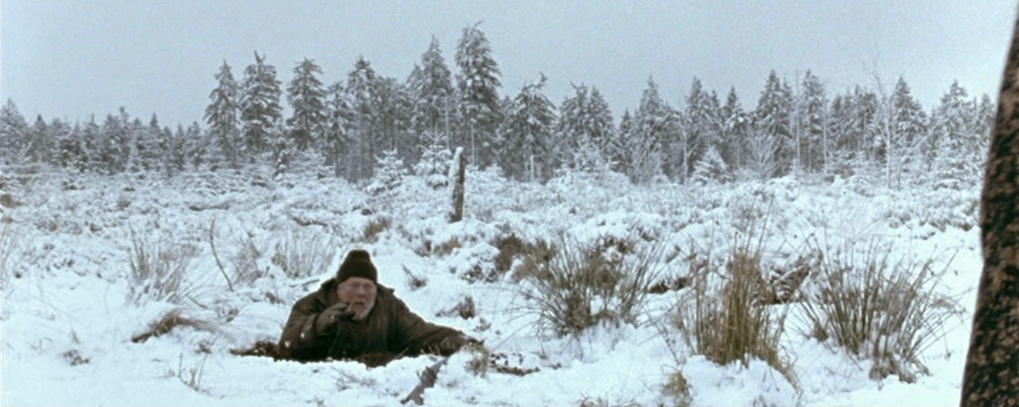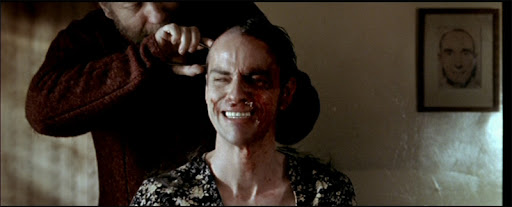‘Calvaire’ Makes Christmas Scary, and Disturbing, Again [Rotten Outlook]

A calvaire, or calvary, is a kind of monumental, public Christian cross, erected in the wilderness, nestled against the woods, often—though not always—encased in an open shrine. There are typically three crosses– that of Jesus Christ and two for both the penitent and impenitent thief, the unnamed thieves present at the crucifixion of Christ. Calvaire, a 2004 Belgian horror film and feature debut for Fabrice Du Welz, exploits the iconography. It’s a brutal, hypnotic, almost unconscionably terrifying Christmas nightmare. It’s also, per critic aggregate Rotten Tomatoes, has “a certain amount of grim potential, but loses effectiveness by too often mistaking disturbing gore for genuine horror.” The story of a young, transient performer (Laurent Lucas) and his time in a backwards, almost mythically depraved rural inn during the Christmas season, it’s thoroughly disturbing. But it isn’t rotten.
Calvaire similarly parallels the current online discourse of depiction and endorsement. It’s a tricky and dense subject, though writ large, it’s almost paradoxical. Depiction doesn’t equal endorsement, but depiction itself is not neutral. Several weeks ago, we revisited The Treatment here, an almost punishingly disturbing movie whose worst moments occur off-screen. Contrast that with several more modern entries into the canon of disturbing film (looking at you, Incident in a Ghostland) and the distinction is clear.
Also Read: ‘Yellowjackets’ Is Disgusting And Perfect For Winter Viewing
While I certainly don’t hope to sound like an old chump, someone pining for the horror of yesteryear, older horror—and especially non-American horror—seems to better understand the nuanced boundary between depiction and ratification. Calvaire doesn’t endorse dismemberment or bestiality, and so much of that comes down to not just depiction, but staging and narrative intent. Calvaire knows just how long to linger on a bloodied corpse, just how far to push its portrayals of animal cruelty.
One of its cousins in the Christmas slasher subgenre, Better Watch Out, similarly strikes the right balance. Director Chris Peckover never lets Better Watch Out trundle off the rails, pushing it too far into exploitation. It gets dangerously close– an early game of truth or dare almost ruins the fun, turning it into something ugly, not simply disturbing. But the intent is never neutral. There is a point, and with a point comes a line.

Calvaire similarly comes close. A climactic siege is little more than an ephemeral chance for escape. What follows is more cruelty toward Marc, not just at the hands of Bartel (Jackie Berroyer), the deranged innkeeper convinced Marc is his wife, but the denizens of the nearby town, people preeminently obsessed with livestock and grim biblical iconography. The violence is gruesome and unnerving. Like so many from both the New French Extremity Movement and its adjacent outputs, Calvaire can at times feel like an ordeal (the English translation for its title).
Also Read: An Apocalypse Makes Christmas Scary: ‘Silent Night’s’ Ending Explained
Where most modern horror operates pursuant to some kind of narrative arc, a conventional template of highs and lows, Calvaire is almost all lows. Marc’s situation spirals from the moment his van breaks down en route to a Christmas performance. He’s a nice enough guy, if a bit of a cad. But the torment and torture he endures far exceeds what’s expected of the genre. It just keeps getting worse, the animal allusions growing more troubling and subversive as Calvaire moves along.
Yet, there’s a point to it all. While it can be difficult to pin down, and like the best genre outputs subject to diverse interpretation, a guiding theme is the monstrosity of men. More than that, it engenders a world wherein men treat each other the way they treat women. Female characters are nearly nonexistent. When they do appear, they’re tender, existing under a kind of nebulous Panopticon whereby they frequently police their behavior, never allowing their monstrous, primal instincts to overwhelm.

Conversely, the men treat Marc—quite literally—as a woman. The toxicity of unchecked masculinity, of feeling entitled to bodies and minds, manifests literally, with Marc dressed as Bartel’s deceased wife. Marc is coveted by not just Bartel, but the men in an adjacent town. The animal symbolism is grounded—men view women as helpless lambs or dogs—and the cruelty serves a point.
Also Read: ‘Kristy’ Makes for a Thanksgiving to Remember [Rotten Outlook]
The psychosexual atmosphere and queer undertones, though overwhelming, delineate the historical parallels. Women were tortured, assaulted, and shaved, treated like animals, for little beyond simply being women. It’s a Belgian reworking of Deliverance, the American shocker that similarly showed the cruelty of men, and it works, despite how disturbing it really is.
Curiously, Calvaire would work as a double feature alongside 2020’s Amulet, Romola Garai’s British shocker about a haunted boarding house. Both adroitly explore the toxicity of men and the pain they cause to women, though in distinctly gruesome ways. Calvaire is not a fun watch, but it’s a worthwhile one. For those who can stomach it, this ostensibly rotten Belgian slasher is worth adding to the Christmas queue.
Categorized:Editorials News Rotten Outlook
